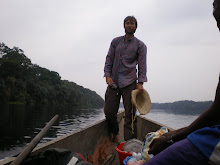I've only just recently realized that I have 3.5 weeks left of research for this dissertation. The only thing left to do after that is to write the damn thing. Consequently I have decided to spend as much time as possible in the forest collecting data. I'll be leaving camp at 4:30 AM and returning at 7:00 PM. This means at least a couple of hours per day in the dark with headlamp and weary steps.
I do enjoy the night walking. Mangue can make the call of the Demidoff's Galago, the smallest primate in Africa, when we're in the swamps. They have what's called a tapetum lucidum, a filament that covers their eyes and reflects light (think cats) that allows us to spot them in the forest with my headlamp. As Mangue mimics them, I can trace the bouncing pair of eyes as they move toward us, territorially regarding the intrusion. They are tiny, but they come down right next to us and look as if their going to jump on our heads. It is, along with other morphological characteristics, the presence of the tapetum that seperates the prosimians (galagos, lemurs, pottos, and lorises-all considered models for the earliest primates) from the anthropoids (monkeys, apes and humans).

Lately, walking at night has conjured up some of my earliest memories. On evenings after thunderstorms, my dad and I would scour the parking lot of the dentist office behind our house in search of nightcrawlers. I can't recall all of the details, but I can remember my excitement when we left the house and spent time in the dark. I quickly learned that things were different at night and that those differences were more than just the absence of the sun.
It probably wasn't too long before I began to take the night and the changes that come alaong with it for granted. It's the funny thing about discovery. The more you know about some things, the less amazing they become. Or maybe as we age we become harder to impress.
I was definitely impressed with my bonobo observation the other day. The bonobos here are what we in the business call "unhabituated." That is, they are not yet accustomed to our presence and tend to flee when they detect us. This of course makes studying their behavior very difficult as I have pointed out before. But Friday was different.
The research team found their nesting site at 5:30 AM and waited until they awoke. They each in turn left their nest, congregated for a few brief moments in a fruit tree on the edge of our visual horizon, and then departed for parts of the forest where we would presumably leave them in peace. A fairly routine sighting.
We hung out for a couple of hours collecting feces, urine (off of leaves), and nest data. Based on the number of nests in the vicinity, we estimated the total party size at 14 individuals not including infants (who share nests with their mothers.) I decided to have a go at finding them again which, compared with the noisy chimpanzees, is difficult because bonobos are usually fairly quiet. Nevertheless, Dipon, are chef from 2007 and newly appointed guide, and I heard them "food chirping." We bushwhacked through some thick vegetation for about 45 minutes and came across a female sharing fruit with her 10 month-old son while a sub-adult male was sharing fruit with an adolescent female (presumably all are related at some level-hopefully the feces I collected will give me the DNA analysis I need to determine their relations). After eating, they all proceeded to lounge in some vines as if they were hammocks while the infant practiced swinging and climbing about-hard not to think of Silas! Several moments later, the mother, with the infant securely clinging to her back, built a day nest and hunkered down for a rest. For a solid hour, we watched the four apes from a mere 20 meters until a troop of mangabey monkeys came through and chased them off.

Fruit sharing and nest building. For a a primate nerd such as myself, these behaviors are amazing to watch. It was far and away my best bonobo sighting and second only to the time I watched a pair of chimpanzees use tools to termite fish in Senegal.

All in all, it was an inspiring day with about two hours of direct observation, 16 fecal samples and 8 urine samples collected, and data on 24 fresh and old nests. A few more days like that and I might actually be able to say something. Regardless, I am beginning to feel a bit torn. I want to get as much data and info as I possibly can but I also can't wait to get home to see Gwen and Silas. It's been a long month and I have another to go. I need to be as efficient as possible with my work, remember how lucky I am to have an opportunity to experience this, and continue to be thankful I have the support of my family. I love you guys.


this is cool
ReplyDeletei look forward to someday having my own themed blog